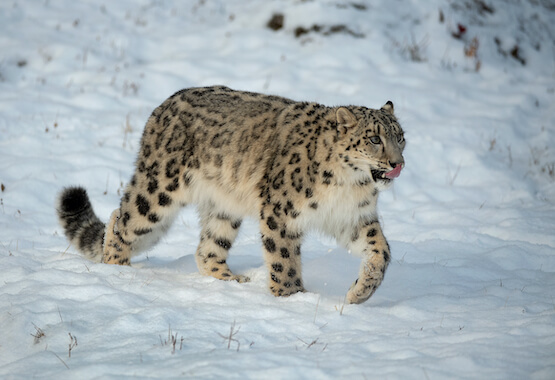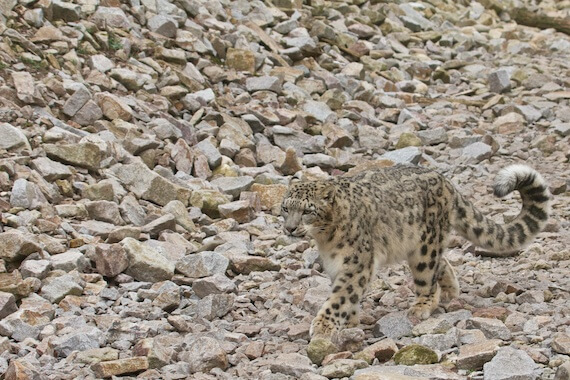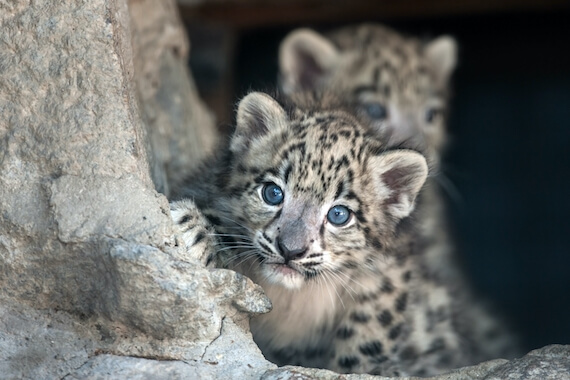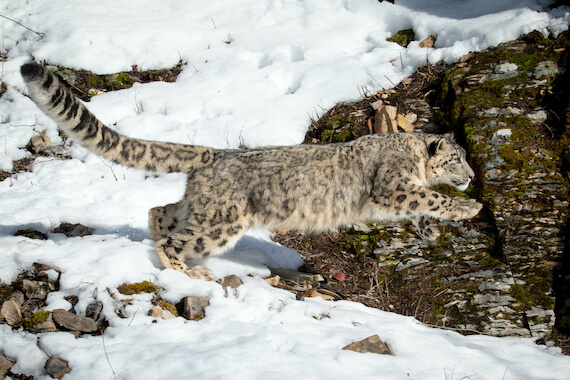
| Kingdom | Animalia |
| Phylum | Chordata |
| Class | Mammalia |
| Order | Carnivora |
| Family | Felidae |
| Genus | Panthera |
| Species | Panthera uncia |
| Niche | Carnivorous alpine big cat |
| Height | 22 – 26 inches (55 – 65 cm) |
| Body Length | 35 – 52 inches (90 – 130 cm) |
| Weight | 77 – 121 lb (35 – 55 kg) |
| Lifespan | 15 – 18 years |
| Social Structure | Solitary |
| Conservation Status | Vulnerable |
| Preferred Habitat | Mountainous regions of central Asia |
| Average Litter Size | 2 – 3 cubs |
| Main Food Item | Wild sheep and goats, livestock |
| Predators | Humans |
The Basics
The snow leopard is a species of big cat native to the mountains of central Asia. Their habitat range covers 2 million km2 and extends into 12 countries. In high latitude countries such as Mongolia and Russia, snow leopards are found at altitudes of around 1,000 meters above sea level. However, in lower latitude countries such as China and India, these cats are found at much higher altitudes of between 3,000 and 5,400 meters above sea level.

Snow leopards prefer the rugged terrain of rocky outcrops, cliffs and ravines above the tree line, as this habitat provides clear views of prey and good cover whilst hunting. In the alpine and sub-alpine zones that these big cats inhabit, the ground is often covered with a thick layer of snow, however this poses no problem for snow leopards. In fact, these animals can travel easily in snow up to 33 inches (85 cm) deep thanks to their large paws, which act as snow shoes and prevent them from sinking into the snow.
Behaviour and Ecology
Snow leopards are crepuscular animals, which means that they are most active at dawn and dusk. These carnivorous predators actively hunt their prey by ambushing them from above and pursuing them down steep mountainsides for up to 300 meters. Snow leopards mainly hunt wild sheep and goats such as the blue sheep, argali sheep and ibex, although they will also prey on smaller mammals such as marmots, voles and hares. Snow leopards are opportunistic hunters, and as a result will also eat carrion and sometimes hunt livestock. Given the large size of the snow leopard’s preferred prey, they are able to survive on a single animal for two weeks, so only hunt such large animals every 8 – 10 days on average.

Snow leopards are solitary animals, although males and females are seen together during the mating season, as are mothers and their young cubs. Individuals occupy huge home ranges up to several hundred square kilometers and patrol these regularly, marking their territories using urine scent marks. It is thought that home range size is related to food availability, with snow leopards in areas of abundant prey using smaller home ranges. Although the territories of males don’t often overlap with each other, they do overlap with those of females.
Snow leopards tend to mate towards the end of winter, meaning cubs are born between April and June. Females give birth to 2 – 3 cubs inside a rocky den lined with fur shed from their undersides. Snow leopard cubs are initially blind, but open their eyes at around 7 days old and are fully weaned by 10 weeks old. Cubs typically leave the den when they are 2 – 4 months old, however they remain with their mother until they are 18 – 22 months old. Once snow leopards leave their mothers, they disperse over very large distances to find new hunting grounds.

Fun Facts about Snow Leopards
Snow leopards are unique amongst the big cats for a number of reasons and as a result demonstrate several interesting biological concepts.
No Roar
The snow leopard shares the genus Panthera with four other members; lions, tigers, leopards and jaguars. But unlike these other four big cats, snow leopards are unable to roar. It was previously thought that the unique ability of these other animals to roar resulted from incomplete ossification of the hyoid bone in the neck. However, snow leopards also share this feature, thus is it now thought that roaring results from a specific morphology of the vocal folds in the larynx, which snow leopards lack. Instead of roaring, snow leopards communicate using sounds similar to those of other large cats, such as purrs, hisses and growls.
Although it was originally thought that snow leopards where the first species to diverge within the genus Panthera, it has recently been shown that they actually form a sister clade with tigers. It is likely that these two groups diverged from the rest of Panthera between 4.62 and 1.82 million years ago, before diverging from each other between 3.7 and 2.7 million years ago. Given that tigers share the ability to roar with the remaining members of the Panthera genus but snow leopards do not, perhaps this was a feature of the Panthera common ancestor that has since been lost in snow leopards following their divergence from tigers.
Alpine Adaptations
In order to survive in their cold alpine habitat, snow leopards have evolved a number of adaptations, which they share with other animals that live in cold environments around the world. For example, snow leopards have long hair with a dense, woolly under-fur and small, round ears. Both of these features help to reduce heat loss from the body and are also found in the polar bear and arctic fox. In addition to these common adaptations, snow leopards also have thick tails up to the same length as their body, which they can wrap around themselves to keep warm, as well as an enlarged nasal cavity that allows cold air to be warmed up before it enters the lungs.

Snow leopards also exhibit a number of adaptations for living on the side of mountains. For example, they have short fore legs, which combined with their long tails, help them to maintain balance on rugged terrain. Furthermore, they have long hind legs, which help snow leopards jump up to 30 feet (10 meters) at once when hunting. Finally, snow leopards are well-camouflaged thanks to their light-coloured fur with dark spots and rosettes that helps them blend in with the mountain.
Apex Predator
Snow leopards are apex predators, which means that they sit at the top of the food chain and have no natural predators themselves. Apex predators tend to be large carnivores and include all other members of the genus Panthera, as well as several species of crocodile, shark and eagle.
Apex predators have an important influence over ecosystems, as they are able to control the population size of their prey and of other predators. Loss of an apex predator due to hunting by humans, for example, could lead to a trophic cascade in which the population sizes of species lower down the food chain change dramatically. This can have profound effects on ecosystems by altering ecosystem structure, biodiversity and nutrient cycling.
